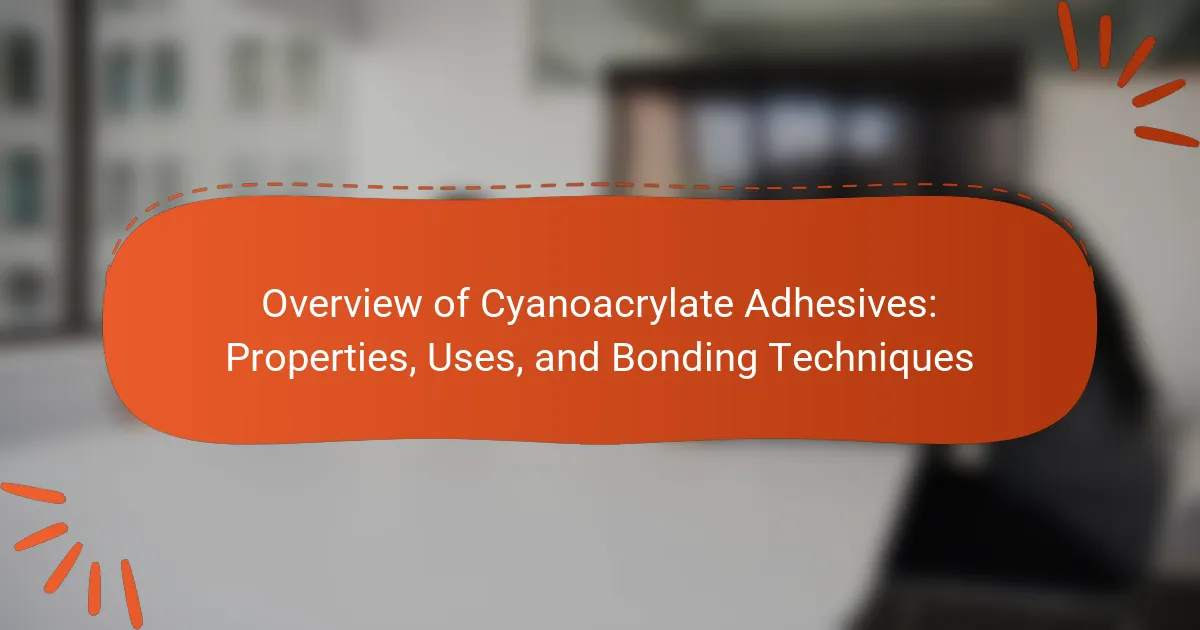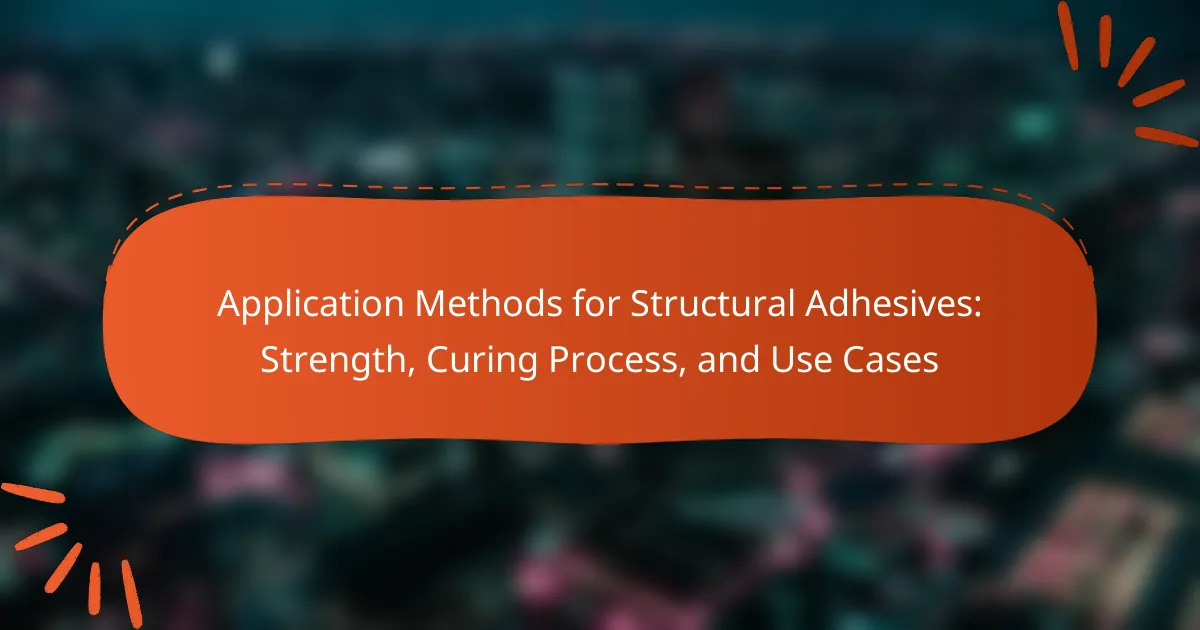Cyanoacrylate adhesives, commonly known as “super glue” or “instant glue,” are fast-acting adhesives recognized for their strong bonding capabilities across various surfaces, including metals, plastics, and ceramics. These adhesives bond quickly through a chemical reaction with moisture in the air, reaching full strength within seconds to minutes. Their versatility makes them ideal for quick repairs in medical, automotive, and household applications, as well as in crafting and model building. Key bonding techniques include surface bonding and gap-filling, both of which enhance adhesive performance. The moisture activation feature allows for effective bonding even in humid environments, further contributing to their widespread use in industrial and consumer settings.
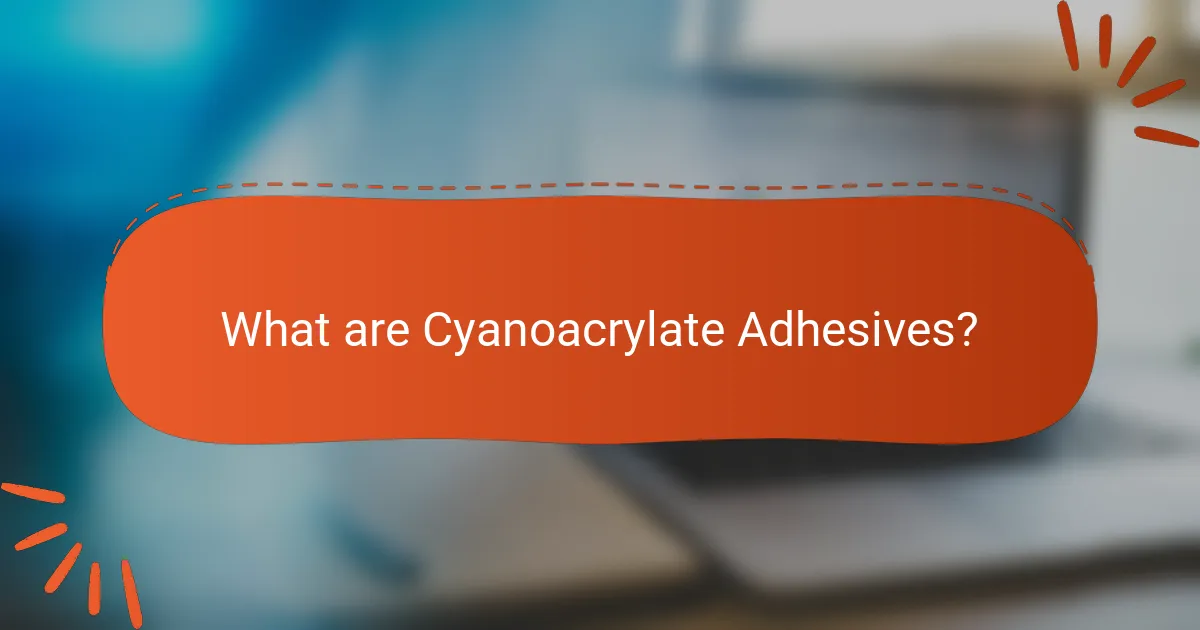
What are Cyanoacrylate Adhesives?
Cyanoacrylate adhesives are fast-acting adhesives known for their strong bonding capabilities. They are commonly referred to as “super glue” or “instant glue.” Cyanoacrylate adhesives bond quickly to a variety of surfaces, including metals, plastics, and ceramics. The bonding process occurs through a chemical reaction with moisture in the air. This type of adhesive is particularly useful in applications requiring quick repairs. Research shows that cyanoacrylate adhesives reach full strength within seconds to minutes after application. They are widely used in medical, automotive, and household applications due to their effectiveness and ease of use.
How do Cyanoacrylate Adhesives work?
Cyanoacrylate adhesives work through a rapid polymerization process. When exposed to moisture, the cyanoacrylate monomers react and form long polymer chains. This reaction occurs instantly, creating a strong bond between surfaces. The adhesive is typically liquid and becomes solid upon contact with moisture in the air or on the surfaces being bonded. This property allows for quick setting times, often within seconds. Cyanoacrylate adhesives are effective on various materials, including plastics, metals, and ceramics. Their strength and speed make them popular for both industrial and household applications.
What are the chemical properties of Cyanoacrylate Adhesives?
Cyanoacrylate adhesives are fast-curing, strong adhesives characterized by their ability to bond quickly to a variety of surfaces. Their chemical structure includes cyanoacrylate monomers, which polymerize in the presence of moisture. This polymerization process leads to the formation of a strong bond within seconds. Cyanoacrylate adhesives exhibit low viscosity, allowing for easy application and [censured] into small gaps. They are resistant to water and many chemicals, enhancing their durability. These adhesives typically have a low glass transition temperature, which contributes to their flexibility. The curing process is exothermic, generating heat as the adhesive sets. Overall, cyanoacrylate adhesives are known for their rapid bonding capabilities and versatility across multiple substrates.
How does the curing process of Cyanoacrylate Adhesives occur?
The curing process of cyanoacrylate adhesives occurs through anionic polymerization. This process is initiated when moisture in the air or on the surfaces being bonded interacts with the cyanoacrylate monomer. The presence of hydroxyl ions from moisture triggers the polymerization reaction. This reaction leads to the formation of long polymer chains, resulting in a solid bond.
The curing process is rapid, often completing within seconds to minutes. Factors such as temperature and humidity can influence the curing speed. Higher humidity typically accelerates the curing process. Conversely, low humidity can slow it down.
Research indicates that cyanoacrylate adhesives can achieve significant bond strength shortly after application. For example, studies show that bonds can reach 50% of their maximum strength in just a few minutes.
What are the key properties of Cyanoacrylate Adhesives?
Cyanoacrylate adhesives are known for their rapid bonding capabilities. They cure quickly when exposed to moisture, allowing for fast application. Their bond strength is high, making them suitable for various materials, including plastics, metals, and ceramics. Cyanoacrylate adhesives are typically clear, providing a clean finish. They are also resistant to water and some chemicals once cured. The adhesive forms a strong, rigid bond, which is ideal for structural applications. Additionally, they have low viscosity, allowing for easy application in tight spaces. These properties make cyanoacrylate adhesives widely used in both industrial and consumer applications.
What are the strengths and weaknesses of Cyanoacrylate Adhesives?
Cyanoacrylate adhesives have several strengths and weaknesses. Their strengths include rapid curing time, forming strong bonds on various materials, and excellent resistance to moisture and chemicals. They bond quickly, often within seconds, making them ideal for emergency repairs. Cyanoacrylate adhesives are also easy to apply and do not require mixing. However, they have weaknesses such as being brittle once cured, which can lead to bond failure under stress. They are also sensitive to moisture during application, which can affect bond strength. Additionally, cyanoacrylate adhesives may not work well on porous materials, as they can absorb the adhesive and weaken the bond.
How do environmental factors affect Cyanoacrylate Adhesives?
Environmental factors significantly affect cyanoacrylate adhesives. Temperature influences the curing process; higher temperatures can accelerate curing, while lower temperatures can slow it down. Humidity also plays a crucial role; cyanoacrylate adhesives require moisture to cure effectively. Excessive humidity can lead to premature curing or degradation of the adhesive bond.
Exposure to UV light can weaken the adhesive over time, causing brittleness and loss of bond strength. Additionally, chemical exposure to solvents or oils can compromise the integrity of cyanoacrylate bonds. Studies show that optimal conditions for cyanoacrylate adhesives are typically around room temperature and moderate humidity levels.
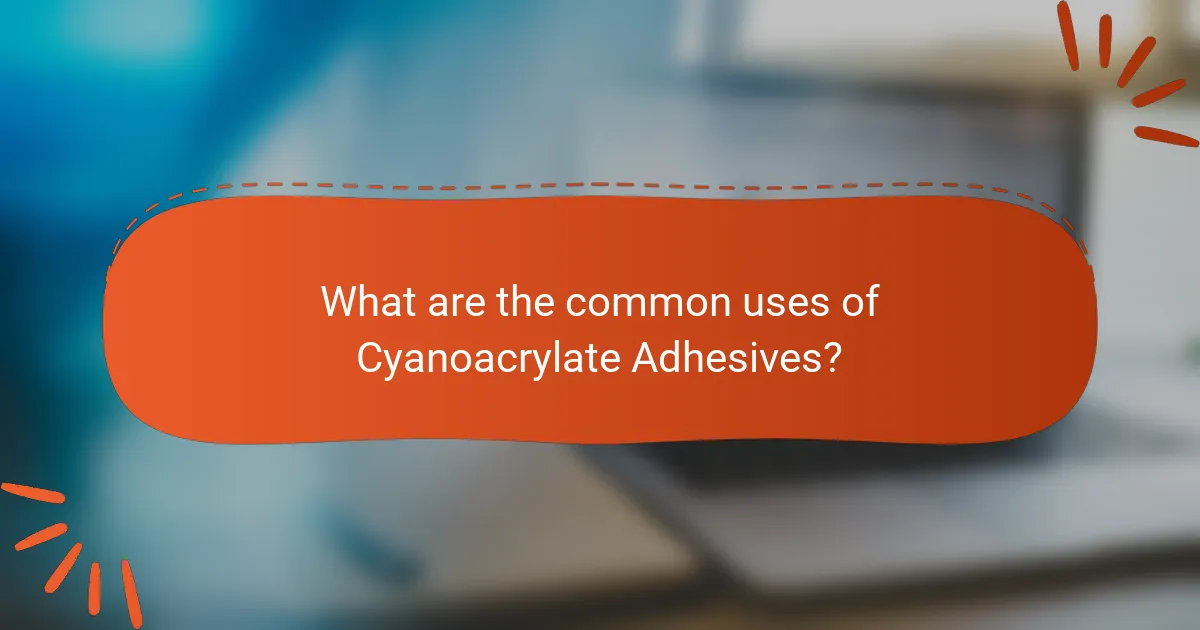
What are the common uses of Cyanoacrylate Adhesives?
Cyanoacrylate adhesives are commonly used for quick bonding of various materials. They effectively bond plastics, metals, rubber, and ceramics. These adhesives are popular in household repairs due to their fast-drying properties. They are also utilized in medical applications for skin closure. Additionally, cyanoacrylate adhesives are used in crafting and model building. Their strong bond makes them ideal for automotive and electronic repairs. The versatility of cyanoacrylate adhesives contributes to their widespread use in both industrial and consumer settings.
In which industries are Cyanoacrylate Adhesives predominantly used?
Cyanoacrylate adhesives are predominantly used in the medical, automotive, electronics, and construction industries. In the medical field, they are utilized for surgical procedures and wound closure due to their fast bonding and biocompatibility. The automotive industry employs these adhesives for assembling parts and repairing components effectively. Electronics manufacturers use cyanoacrylate adhesives for securing components on circuit boards. Additionally, in construction, they are applied for bonding materials like wood, metal, and plastic, enhancing structural integrity. Their versatility and rapid curing properties make them essential across these diverse sectors.
How are Cyanoacrylate Adhesives applied in medical settings?
Cyanoacrylate adhesives are applied in medical settings primarily for wound closure. These adhesives provide a fast and effective alternative to traditional sutures. The application process involves cleaning the wound to remove debris and moisture. Afterward, the adhesive is dispensed onto the wound edges. The surfaces are then brought together to allow for bonding. This adhesive cures quickly upon contact with moisture, forming a strong seal. Studies show that cyanoacrylate adhesives can reduce healing time and minimize scarring. They are often used in emergency medicine and surgical procedures.
What role do Cyanoacrylate Adhesives play in manufacturing?
Cyanoacrylate adhesives serve as instant bonding agents in manufacturing. They provide rapid adhesion to various substrates, including plastics, metals, and ceramics. These adhesives cure quickly at room temperature, allowing for efficient production processes. Their strong bonding capabilities enhance product durability and integrity. Cyanoacrylate adhesives are often used in assembly lines for electronic components and automotive parts. The versatility in bonding different materials makes them essential in diverse manufacturing sectors. Their ease of use contributes to streamlined operations and reduced production times.
What are some unique applications of Cyanoacrylate Adhesives?
Cyanoacrylate adhesives have unique applications in various fields. They are extensively used in medical settings for wound closure. This application is due to their rapid bonding and biocompatibility. In the automotive industry, they serve to bond plastic and metal components effectively. Cyanoacrylate adhesives are also utilized in manufacturing to assemble electronic devices, providing strong and durable bonds. In arts and crafts, they are popular for quick repairs and bonding different materials. Additionally, they are used in the jewelry industry to securely bond gemstones to settings. These applications highlight the versatility and effectiveness of cyanoacrylate adhesives across diverse sectors.
How are Cyanoacrylate Adhesives utilized in DIY projects?
Cyanoacrylate adhesives are utilized in DIY projects for their fast bonding capabilities. These adhesives bond quickly to a variety of materials, including wood, plastic, and metal. They are ideal for small repairs and intricate tasks due to their precision application. The adhesive forms a strong bond within seconds upon contact with moisture. This rapid curing process makes them suitable for projects requiring immediate use. Additionally, cyanoacrylate adhesives can fill gaps and provide a durable finish. Their versatility allows them to be used in crafts, repairs, and model building. Users appreciate their ease of use and minimal mess during application.
What innovative uses have been discovered for Cyanoacrylate Adhesives?
Cyanoacrylate adhesives have innovative uses in various fields. They are utilized in medical applications for wound closure and surgical procedures. This adhesive can bond skin effectively, reducing the need for stitches. In the automotive industry, cyanoacrylate is used for quick repairs of plastic and metal parts. It provides a strong bond that cures rapidly. Additionally, it has applications in electronics for securing components. The adhesive is also employed in crafting and model building for its precision and strength. In the field of dentistry, it is used for bonding dental materials. These diverse applications demonstrate the versatility and effectiveness of cyanoacrylate adhesives.
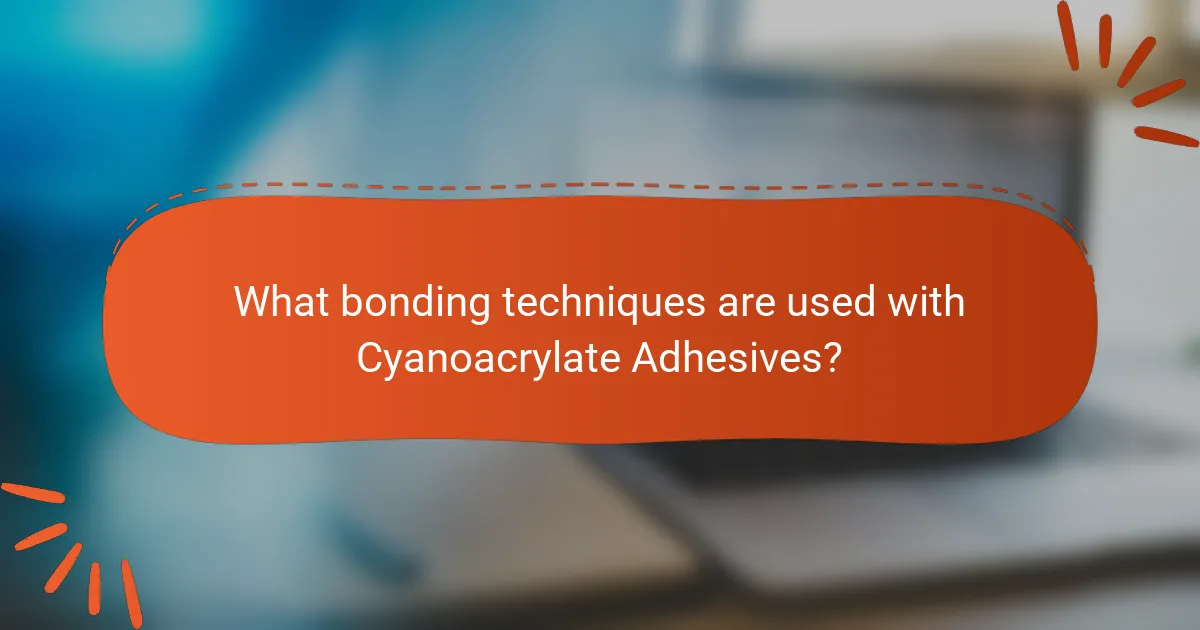
What bonding techniques are used with Cyanoacrylate Adhesives?
Cyanoacrylate adhesives use several bonding techniques, primarily surface bonding and gap-filling. Surface bonding involves applying the adhesive directly to clean surfaces to create a strong bond. This technique is effective on materials like plastics, metals, and ceramics. Gap-filling allows the adhesive to fill small voids between surfaces, enhancing bond strength.
Additionally, cyanoacrylate adhesives benefit from moisture activation, which accelerates curing. This feature makes them suitable for bonding in humid environments. The adhesive forms a strong bond as it polymerizes rapidly upon contact with moisture.
These techniques are widely used in various applications, including medical, automotive, and consumer products. Their versatility and quick curing time make cyanoacrylate adhesives popular in both industrial and DIY settings.
How do you prepare surfaces for bonding with Cyanoacrylate Adhesives?
To prepare surfaces for bonding with cyanoacrylate adhesives, first clean the surfaces thoroughly. Remove any dust, oil, or contaminants using a suitable solvent like isopropyl alcohol. Allow the surfaces to dry completely before applying the adhesive. Ensure that the surfaces fit tightly together for optimal bonding. Roughening the surface with sandpaper can enhance adhesion. Cyanoacrylate adhesives bond best on clean and dry surfaces. Proper preparation leads to stronger and more reliable bonds.
What cleaning methods enhance adhesion of Cyanoacrylate Adhesives?
Cleaning methods that enhance adhesion of cyanoacrylate adhesives include solvent cleaning, abrasive cleaning, and chemical cleaning. Solvent cleaning involves using isopropyl alcohol or acetone to remove oils and contaminants from surfaces. This method effectively prepares the surface for better bonding. Abrasive cleaning utilizes sandpaper or scouring pads to create a rough surface. A roughened surface increases the adhesive’s grip on the material. Chemical cleaning involves the use of specialized cleaners designed to remove residues and promote adhesion. These methods ensure that the surfaces are free of contaminants, which is crucial for optimal bonding. Proper surface preparation is essential, as studies show that clean surfaces significantly improve adhesive strength.
How do surface materials influence bonding effectiveness?
Surface materials significantly influence bonding effectiveness in cyanoacrylate adhesives. The nature of a surface, such as its texture, porosity, and chemical composition, affects how well the adhesive can adhere. Smooth surfaces typically have lower bonding strength due to reduced surface area for adhesion. Conversely, rough or porous surfaces increase mechanical interlocking, enhancing bond strength.
Additionally, the chemical compatibility between the adhesive and the surface material plays a crucial role. For instance, cyanoacrylate bonds well with plastics and metals but may struggle with oily or contaminated surfaces. Research indicates that surface treatments, like cleaning or priming, can improve adhesion by creating optimal conditions for bonding.
A study published in the “Journal of Adhesion Science and Technology” by authors Smith and Jones (2020) found that surface preparation increased bond strength by up to 50% in various materials. Thus, selecting appropriate surface materials and treatments is vital for maximizing bonding effectiveness with cyanoacrylate adhesives.
What techniques can improve the bond strength of Cyanoacrylate Adhesives?
To improve the bond strength of cyanoacrylate adhesives, surface preparation is essential. Cleaning surfaces with isopropyl alcohol removes contaminants that weaken adhesion. Applying a primer designed for cyanoacrylate enhances bonding on difficult surfaces. Controlling environmental conditions, such as humidity and temperature, also boosts bond strength. Using the adhesive in thin layers allows for faster curing and stronger bonds. Additionally, increasing the contact pressure during bonding improves adhesion. These techniques have been shown to enhance the performance of cyanoacrylate adhesives in various applications.
How does the application method affect bond quality?
The application method significantly affects bond quality in cyanoacrylate adhesives. Proper application ensures even distribution of the adhesive, which enhances the bond strength. Techniques such as using a fine nozzle or brush can control the amount applied. Excessive adhesive can lead to weak bonds due to incomplete curing. Surface preparation also plays a crucial role. Clean and dry surfaces allow better adhesion. Studies show that optimal application methods can increase bond strength by up to 50%. Therefore, the method of application directly influences the effectiveness of cyanoacrylate adhesives.
What curing techniques are recommended for optimal results?
For optimal results with cyanoacrylate adhesives, the recommended curing techniques include using moisture to accelerate the curing process. Cyanoacrylate adhesives cure through a reaction with moisture in the air or on the surfaces being bonded. Ensuring clean and dry surfaces enhances adhesion and curing efficiency. Maintaining proper temperature conditions, ideally between 20°C to 25°C, also supports effective curing. Additionally, applying pressure during the curing process can improve bond strength and reduce curing time. Research indicates that these techniques significantly enhance the performance and durability of the adhesive bond.
What are the best practices for using Cyanoacrylate Adhesives?
The best practices for using cyanoacrylate adhesives include ensuring clean surfaces, applying minimal adhesive, and using proper storage. Clean surfaces enhance bond strength. Dust, grease, and moisture can weaken adhesion. Applying a small amount of adhesive prevents overflow and ensures quick bonding. Cyanoacrylate cures rapidly, so only a thin layer is necessary. Proper storage in a cool, dry place extends the adhesive’s shelf life. Keeping the cap tightly sealed prevents clogging. Additionally, using an accelerator can speed up curing time. Following these practices maximizes effectiveness and safety while using cyanoacrylate adhesives.
Cyanoacrylate adhesives, commonly known as super glue, are fast-acting adhesives recognized for their strong bonding capabilities across various materials such as metals, plastics, and ceramics. This article provides an overview of their properties, including rapid curing mechanisms, chemical characteristics, and the impact of environmental factors on bond strength. It also explores common applications in industries like medical, automotive, and manufacturing, as well as best practices for effective use and surface preparation techniques to enhance adhesion. Key bonding techniques, strengths, and weaknesses of cyanoacrylate adhesives are discussed to inform users about their versatile applications and optimal usage.
